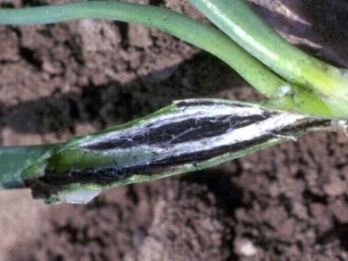Onion smut
Onion smut is a plant disease affecting the allium family, in particular, onions and shallots.
Background
Onion smut has been sporadically detected in South Australia since the 1950s. Infection can increase during cool, wet spring conditions because onion seedlings grow slowly, and the flag leaf is in the soil for a longer period.
The potential for natural dispersal is limited. Onion smut spreads through contact with diseased seedlings and infected soil. It can travel between properties on clothing, shoes, equipment and vehicles that are contaminated.
Impact
Onion smut has minor impact in terms of yield or financial loss. Other than onions, it can affect spring onions, leeks, garlic and chives.
This soil borne disease is caused by the fungus Urocystis cepulae, which can remain dormant as spores in the soil and may persist for years. It attacks only the seedling stage, with most infected plants dying at 3 to 5 weeks of age. Each developing leaf is susceptible for a short time, which decreases with leaf and plant age.
Diseased plants that survive are often distorted and will not develop marketable produce. As a result, any vegetables from infected areas that reaches market is unlikely to carry the disease.
Onion smut is not a public health risk and onions are still safe to eat.
Mangement
Mangement
Onion smut can be managed through:
- using resistant varieties
- fungicide seed treatment to protect emerging seedlings
- in-furrow application of fungicide at seeding
- cultural control, including cultivation under conditions that favour rapid host growth
- cropping rotations
- soil fumigants.
It is important to remain vigilant and adopt on-farm biosecurity practices that will protect crops. Consider the following:
- decontaminate machinery and restrict movement where possible
- check onions or other susceptible plants are free of soil prior to movement
- keep bins free from soil or plant material, or remove bins from your production system and harvest directly into trailers which are cleaned down between paddocks
- display signage on your farm and brief all workers of biosecurity impacts
- use a visitor register on your farm to track movements
- provide cleaning materials such as scrubbing brushes, disinfection footbaths, boot covers, rubber boots and protective disposable clothing for anyone entering or leaving your farm.
Identification
Onion smut has distinctive narrow, dark streaks, usually on the cotyledon (embryonic leaf) or the first true leaf. These streaks thicken, which is the most visible symptom on the plant.
The infection inside the leaf later bursts through the surface and releases masses of dark-brown powdery spores.
Plants that survive onion smut become stunted, distorted, develop blisters on the green leaf tissue, and the leaves may curve downward due to large lesions.

